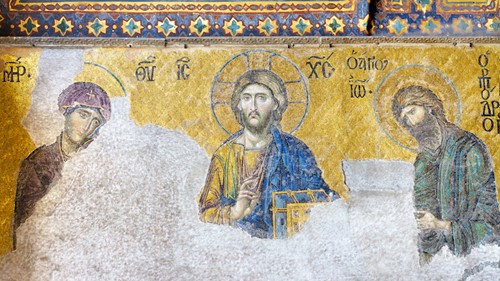"Mosaic of the Deesis" (Canvas replica displayed in our church sanctuary)
 In December of 1931, Thomas Whittemore led a team of archeologists, historians, craftsmen, and restorers from the Byzantine Institute of America to Istanbul in order to do a complete survey of the Church of Hagia Sophia (Greek for Holy Wisdom). The church was dedicated to the Wisdom of God, the Logos, the Second Person of the Trinity. From the date of its construction in 537 AD, and until 1453, it served as an Eastern Orthodox cathedral and seat of the Patriarch of Constantinople, except between 1204-1261, when it was converted by the Fourth Crusaders to a Roman Catholic cathedral under the Latin Empire. The building was later converted into an Ottoman mosque from 1453 until 1931. It was then secularized and opened as a museum on 1 February 1935.
In December of 1931, Thomas Whittemore led a team of archeologists, historians, craftsmen, and restorers from the Byzantine Institute of America to Istanbul in order to do a complete survey of the Church of Hagia Sophia (Greek for Holy Wisdom). The church was dedicated to the Wisdom of God, the Logos, the Second Person of the Trinity. From the date of its construction in 537 AD, and until 1453, it served as an Eastern Orthodox cathedral and seat of the Patriarch of Constantinople, except between 1204-1261, when it was converted by the Fourth Crusaders to a Roman Catholic cathedral under the Latin Empire. The building was later converted into an Ottoman mosque from 1453 until 1931. It was then secularized and opened as a museum on 1 February 1935.
The Institute had the complete support of the Turkish government in their scientific expedition which was, in fact, a kind of treasure hunt: using a map left by a pair of Swiss architects who had worked in Hagia Sophia almost 100 years before, the team was using their notes to find Byzantine art that had been lost for almost half a millennium. The Fossati brothers, Gaspare and Giuseppi, in their 1849 restoration and redecoration of the mosque, discovered, sketched, and re-concealed several major works of Byzantine art. The Institute had the brothers' sketched reconstructions, and ideas about where the works might be located, but only had the vaguest hope to find them, as Hagia Sophia had sustained massive damage in an 1894 earthquake, and there was no guarantee that the works remained. Whittemore, however, was undeterred and began examining a wall in the eastern part of the upper south gallery, quickly striking gold. The team had found what they were looking for.
The first incision into the plaster took place on 14 July 1934. The first season of work took four months and ended in late November of the same year. The uncovering of this mosaic panel was the first step, but further conservation, consolidation, and study lasted through seasons of work between the years of 1936-1938. It was a slow and deliberate effort. As the team uncovered the mosaic, they realized that they were unveiling a work of art of world significance. This filled them with awe and made them even more cautious in their excavation and conservation.
Muslims and Christians alike were amazed by the Deesis panel and recognized this was a significant discovery of global interest. Deesis, of Greek origin, is a representation in Byzantine art of Christ enthroned and flanked by the Virgin Mary and Saint John the Baptist. The Deesis panel measures 19.5 feet wide and 13.5 feet tall.
Publication of the discovery of the mosaic created a sensation in the art world. Never before had a Byzantine mosaic of this artistry been seen and the level of technique surpassed anything previously known. The mosaics went a long way towards redeeming Byzantine art in the view of art historians and public opinion, the art of Byzantium having been denigrated for centuries. The extraordinary quality of the Deesis and the stunning visual impression it made upon all who saw it, changed minds about the importance of Byzantine art, its originality, and creativity.
The skill with which the mosaic is made is amazing. The mosaic is laid with an astonishing exactness, seen especially in the many tiny tesserae (small blocks of stone, tile, glass or other material used in the construction of a mosaic) making up the faces. A vast number of colors were used in the work and many of the tesserae are laid at angles to take advantage of raking light from the window to the left of the panel. This light transfuses the glass tesserae and seems to illuminate them from within.
The panel must be the work of a team and the size of the work would require weeks of planning, preparation of the materials and surfaces, and then followed by the work of a team of skilled craftsmen. They cut no corners in the execution of the Deesis. Even the gold background and insides of halos are set in exact and subtle patterns that are not only decorative, but make subtle use of the light in this specific location. The artisans of the Deesis had the accumulated knowledge of generations of craftsmen who had been responsible for the vast expanses of monumental mosaics in the golden vaults and domes of Constantinople.
It appears most of the damage to the figure of the Virgin was most likely caused by wind and rain from the huge window to her left. For decades, the elements poured through these windows which were open to the outside.
During World War II, the Deesis was covered to protect it from harm until after the war. The mosaic did not become popular and well-known until recently. Today, the Christ of the Deesis has become one of the preeminent images of Jesus in the world.
Posted: Tuesday, April 3, 2018